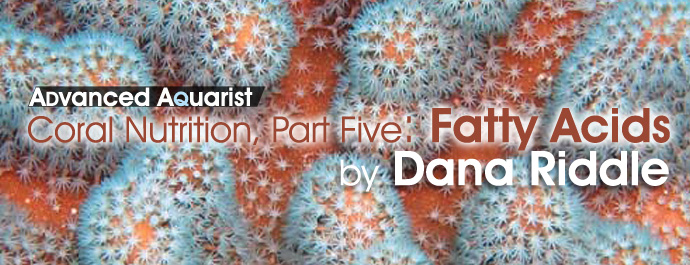
Part One of this series examined the symbiotic relationship between the coral animal and its dinoflagellate (Symbiodinium), and the general nutritional requirements of each, Part Two described foods for corals while Part Three dealt with proteins and their ‘building blocks’ called amino acids. Part Four described possible relationship of nutrient transfer to zooxanthellae and low water motion. This time, we’ll begin to examine coral/zooxanthellae lipids and their subunits called fatty acids.
Understanding lipid content of corals helps us realize the respective contributions of their symbiotic algae and feeding. Since some food sources have lipid identification markers, we can begin to describe the animals’ feeding preferences.
Glossary
- Azooxanthellate: Without zooxanthellae. Corals containing zooxanthellae are said to be zooxanthellate.
- Chemotaxonomy: A method of classifying organisms according to similarity of compounds. Ester: Compounds derived from a combination of a carboxylic acid (-COOH) and an alcohol.
- Fat: A lipid that is semisolid at room temperature. Fatty Acids: A carboxylic acid (COOH) with a long aliphatic tail (consisting of hydrogen and carbon.) Fatty acids are stored as neutral lipids called triacylglycerol or wax esters. Abbreviated as FA.
- Lipids: A class of organic compounds including fats, waxes, sterols, and others.
- Neutral Lipids: Includes triacyglycerols, waxes, sterols and free fatty acids. Oil: A lipid that is liquid at room temperature.
- Polar Lipids: Includes phospholipids and glycolipids.
- Sterols: Naturally-occurring compounds in plants (phytosterols) and animals (cholesterol.) Sterols are sometimes called steroid alcohols. Some researchers believe sterols are superior indicators of the type of diet preferred by a coral.
- Steroids: Organic compounds synthesized by plants, animals and fungi, including sex hormones (such as estrogen), anabolic steroids (which can increase bone and muscle synthesis), and others.
- Cholesterol: A sterol found in animals.
- Phytosterol: A sterol found in plants.
- Triacylglycerides (or triglycerides): Triacylglycerides serve as energy store and a reserve of essential fatty acids, and can be released upon demand.
- Terpene: A type of lipid that is used by corals as defense mechanisms. A familiar terpene is turpentine derived from pine trees. A dipterpene (Sarcophine, made by the soft coral Sarcophyton) is toxic to freshwater fish (Gambusia affinis) at concentrations as low as 3 mg/L. (Ne’eman et al., 1974.)
- Translocation: Transfer of a product produced by zooxanthellae to the coral animal. Wax Esters: A type of lipid that usually serves as an energy store – wax esters are indigestible. These compounds are derived from an acid in which at least one hydroxyl group (-OH) is replaced by an alkyl group.
Lipids
Lipids are a large group of naturally-occurring organic compounds including waxes, sterols, fat-soluble vitamins (A, D, E, and K), and fats such as monoglycerides, diglycerides, triglycerides, and others. These are insoluble in water and, along with proteins and carbohydrates, are major components of plant and animal cells. Lipids can act as energy reserves or structural components. The term ‘fat’ generally is in reference to those lipids that are solid at room temperature, while ‘oil’ refers to those that are liquid at room temps.
Corals can contain a lot of lipid – See Figure 1 for a rough estimate of coral tissue content.
Figure 2 shows amounts of lipid found in tissues of various corals.
Organic compounds called ‘fatty acids’ are the ‘building blocks’ of lipids, and are composed of mostly carbon atoms, along with some oxygen and hydrogen atoms. Fatty acids consist of a ‘backbone’ of an even-number of carbon atoms, with a carboxyl group (-COOH) at the beginning, and a methyl group (CH3) at the omega end, with hydrogen atoms sometimes attached to each carbon found in the backbone.
Unsaturated Fatty Acids can contain one double bond (these are called monounsaturated fatty acids, or MUFAs) or polyunsaturated fatty acids (PUFAs) Polyunsaturated fatty acids (PUFAs) are fatty acids that contain 3 double bonds in their 20 carbon backbone. This means a double bond is 3 carbons away from the methyl omega () end. If the issue can be confused even more, some use the term highly unsaturated (HUFAs), meaning an intermediate amount. Popular dietary supplements for people sometimes contain unsaturated ‘Omega-3’ fatty acids derived from fishes or nuts. How important are Omega-3 fatty acids for corals?
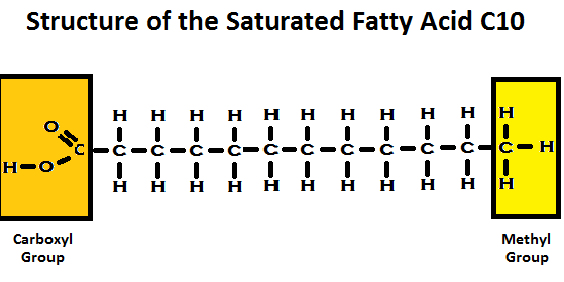
Figure 3. This is the structure of a saturated fatty acid called ‘C10’ (due to ten carbons in the backbone.) A carboxyl group is at the ‘head’ of this carbon chain. At the end (the omega) is a methyl group. Note each carbon in the backbone is attached to hydrogen atoms (the carbon chain is saturated with hydrogens.)
Fatty acids can be either ‘saturated’ or ‘unsaturated’ with these hydrogen atoms.
If a fatty acid has a hydrogen atom attached to each carbon in the backbone, it is said to a ‘saturated’ fat (meaning the carbons are saturated with hydrogens.) Figure 3 shows the structure a saturated fatty acid.
An unsaturated fatty acid is a bit different from one that is saturated, and Figure 4 details these. An unsaturated fatty acid is similar to a saturated one, meaning it is still composed of carbon, hydrogen, and oxygen atoms, with a carboxyl group at one end, and a methyl group at the other. The major difference is the presence of one or more double bonds within the carbon backbone. The double bond(s) is not attached to hydrogen atoms; therefore the carbon chain is NOT saturated with hydrogens, and is referred to as being ‘unsaturated.’ A quick count will reveal 18 carbons with the chain (not counting the carbons in the carboxyl or methyl ends.) Hence, it is denoted as fatty acid C18. There is one double bond (making it 18:1) at the 9th carbon from the methyl end, and this can be noted in a couple of ways. In this drawing, it is called 18:1 n-9 (meaning one double bond is found in the 18 carbon backbone, and it is located after the 9th carbon from the methyl group end.) It can also be denoted as 18:1 9, with the double bond found 9 carbons away from the methyl group ‘tail’, or the omega (.)
Unsaturated Fatty Acids
Polyunsaturated fatty acids (PUFAs) are fatty acids that contain more than one double bond (sometimes defined as at least 3) in their backbone. Monosaturated Fatty Acids (MUFAs) have one double bond.
Now that we have an understanding of what a lipid is, and what it is composed of, we can now make a list of fatty acids along with notes about their synthesis, what makes or contains them (coral, zooxanthellae, and zooplankton.)
We begin our list with Saturated Fatty Acids, followed by Omega-3 and -6 FAs, and ending with an assortment of FAs that are relevant.
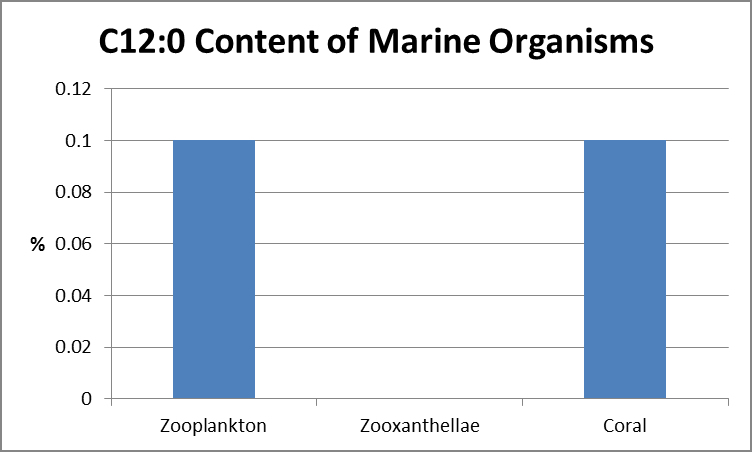
Figure 5. Corals and zooplankton contain roughly the same (albeit small) amounts of the saturated FA C12:0.
Saturated Fatty Acids
Recall the Saturated Fatty Acids have no double bonds; therefore their ‘shorthand’ name will always end with a zero.
- Number of Carbons: 12
- Shorthand: 12:0
- Number of Carbons: 14
- Shorthand: 14:0
- Common Name: Myristic
- Comments: Made by plants and occasionally by animals. Decreased slightly with depth in Stylophora pistillata (Latyshev et al., 1991.)
- Number of Carbons: 16
- Shorthand: 16:0
- Common Name: Palmitic
- Comments: Made by plants and sometimes animals. Palmitic Acid (or hexadecanoic acid) is often the most common fatty acid found in corals and other invertebrates such as Okinawan corals (zooxanthellate soft coral Lobophytum crassum and azooxanthellate Tubastrea), hydrocoral Millepora murrayi) and anemone Boloceroides (Yamashiro et al., 1999.) Unusually high (49.1% of total lipid) in Porites lutea (Latyshev et al., 1991.) Other Poritidae corals contained only 15-17%.) On the other hand, Acropora corals also have high amounts (~25 to 43%.) The major saturated FA in zooxanthellae (Treignier et al., 2008.)
In animals, excess carbohydrates in their bodies are converted to palmitic acid. It is one of the first fatty acid produced and is a precursor to longer chain fatty acids.
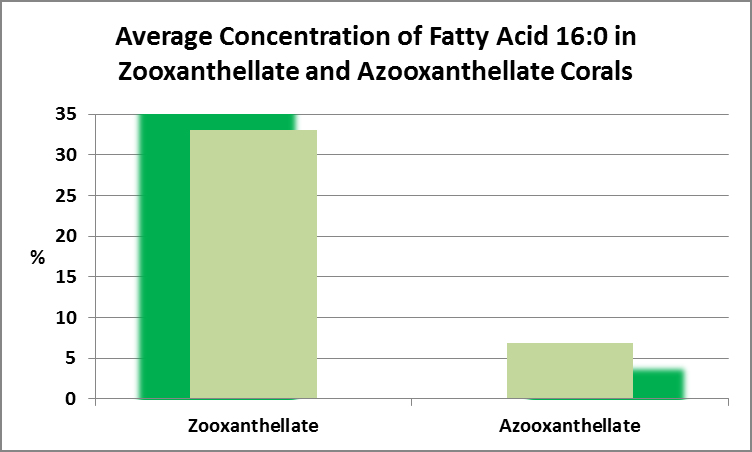
Figure 8. 16:0 content varies greatly between corals that contain zooxanthellae, and those that do not.
- Number of Carbons: 17
- Shorthand: 17:0
- Common Name: Heptadecylic
- Comments: Useful for chemotaxonomy of Dendronephthya species. Found in small amounts of zooplankton and a coral (0.4% and less), but not zooxanthellae (Treignier et al., 2008.) Usually found in dairy products.
- Number of Carbons: 18
- Shorthand: 18:0
- Common Name: Stearic
- Comments: Made by plants and animals. Second most common FA in Okinawan corals (zooxanthellate soft coral Lobophytum crassum and azooxanthellate Tubastrea), hydrocoral Millepora murrayi) and anemone Boloceroides (Yamashiro et al., 1999.)
- Number of Carbons: 20
- Shorthand: 20:0
- Common Name: Arachidic
- Comments: Found in zooxanthellae and zooxanthellate corals in small amounts (<2% 0f total lipid.)
- Number of Carbons: 22
- Shorthand: 22:0
- Common Name: Behenic
- Number of Carbons: 24
- Shorthand: 24:0
- Common Name: Lignoceric
- Number of Carbons: 26
- Shorthand: 26:0
- Common Name: Cerotic
Unsaturated Fatty Acids
Unsaturated Fatty Acids include Omega-3, – 6, -7and -9. In the marine environment, virtually all FAs are Poly-Unsaturated Fatty Acids, or PUFAs containing more than 20 carbons as their backbone and 3 double bonds.) We’ll begin with the Omega-3 PUFAs.
Omega-3 Fatty Acids
The Omega-3 FA 18:3n-3 cannot be made by animals, therefore it is considered ‘essential.’
- Number of Carbons: 18
- Shorthand: 18:3 n-3
- Common Name: -linolenic, or ALA
- Comments: An essential fatty acid for animals, including corals, and made by zooxanthellae. It is one of the predominant PUFAs in Acropora specimens (Latyshev, 1991.) Surprisingly, there is little information available for this FA and cnidarians.
- Number of Carbons: 18
- Shorthand: 18:4 n-3
- Common Name: Stearidonic acid, or SDA
- Comments: This FA can be translocated to the coral animal by healthy zooxanthellae. This FA is a specific marker for Dinophycae but is rare in other microalgae. High levels (along with 18:3n-6) in corals might be attributed to high amounts of zooxanthellae. In Acropora and Sinularia corals, this FA is produced mainly by zooxanthellae. Considered a marker PUFA for Symbiodinium, but oddly it has been described as a useful for chemotaxonomy of azooxanthellate Dendronephthya species. Found in low concentrations (relative to 18:1) in thylakoid bodies of thermally-tolerant zooxanthellae (thylakoids are where chlorophylls and accessory photopigments are maintained.)
- Number of Carbons: 18
- Shorthand: 18:5 n-3
- Common Name:
- Comments: Made by animals and dinoflagellates, but likely in small amounts by corals as Imbs et al. (2014) consider this FA to be a marker PUFA for Symbiodinium.
- Number of Carbons: 20
- Shorthand: 20:3 n-3
- Common Name: Eicosatrienoic or ETA
- Comments:
- Number of Carbons: 20
- Shorthand: 20:4 n-3
- Common Name:
- Comments: Made by animals and dinoflagellates.
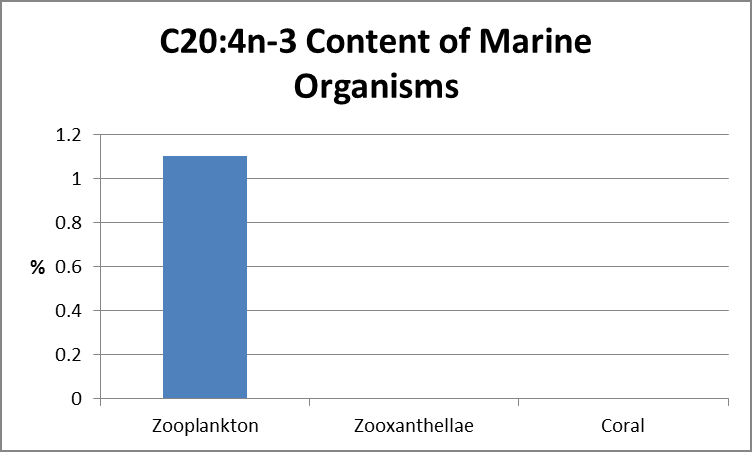
Figure 18. On the other hand, Treignier et al. (2008) found no C20:4n-3 in a coral (Turbinaria reniformis.)
- Number of Carbons: 20
- Shorthand: 20:5 n-3
- Common Name: Eicosapentaenoic, or EPA.
- Comments: Humans have a limited ability to synthesize this FA. In Acropora and Sinularia corals, this FA is produced mainly by zooxanthellae, and Imbs et al. (2014) consider this FA to be a marker for Symbiodinium. One of the predominant PUFAs in Acropora specimens, along with 22:6n-3 (Latyshev, 1991.) This FA decreased with depth (3 to 35m) in Stylophora pistillata (Latyshev et al., 1991.) Inhibition of photosynthesis in some microalgae can cause decreased biosynthesis of this FA (while synthesis of 20:4n-6 increases.)

Figure 20. The average content of this FA is surprisingly constant among results of various researchers.
- Number of Carbons: 22
- Shorthand: 22:5 n-3
- Common Name: Clupanodonic, or DPA
- Comments: This FA can accumulate due to low desaturase enzyme activity but produced mainly by zooxanthellae in Acropora and Sinularia corals (Imb et al., 2010.) Oddly enough, this FA is the highest in azooxanthellate Dendrophyllidae corals.
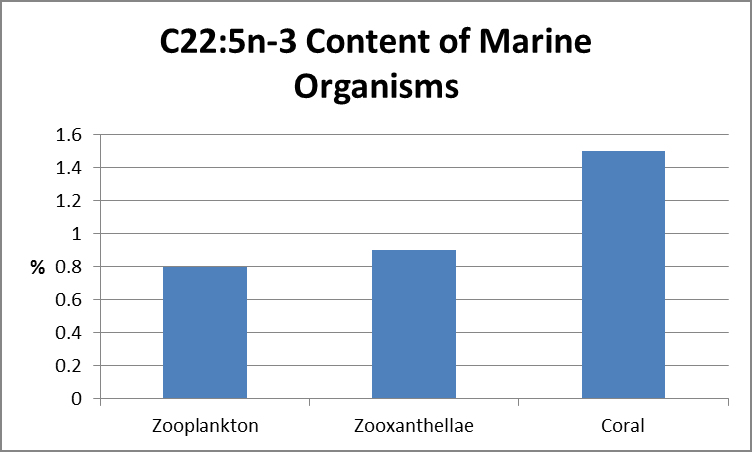
Figure 22. The average content of this FA is consistent among zooxanthellate stony corals.
- Number of Carbons: 22
- Shorthand: 22:6 n-3
- Common Name: Docosahexaenoic, or DHA.
- Comments: Humans have a limited ability to synthesize this FA. This FA is a specific marker for Dinophycae but is rare in other microalgae. Generally, the highest PUFA in zooxanthellate corals, but low (~1.4%) in azooxanthellate Tubastrea colonies. Produced mainly by zooxanthellae in Acropora and Sinularia corals. It is also the major omega-3 of zooplankton (Treignier et al., 2008.) One of the predominant PUFAs in Acropora specimens.
- Number of Carbons: 24
- Shorthand: 24:5 n-3
- Common Name: Tetracosatetraenoic Acid
- Comments: Made by animals and dinoflagellates.
- Number of Carbons: 24
- Shorthand: 24:6 n-3
- Common Name: Tetracosahexaenoic Acid
- Comments: This FA can be synthesized by soft corals but not stony corals thus making it a chemotaxonomic marker for soft corals.
- Number of Carbons: 28
- Shorthand: 28:8 n-3
- Common Name: OOA
- Comments: Made by dinoflagellates.
Omega-6 Fatty Acids
Omega-6 FAs are derived from the immediate precursor Linoleic Acid (18:2n-6.) This FA is produced by zooxanthellae or phytoplankton.
- Number of Carbons: 18
- Shorthand: 18:2 n-6
- Common Name: Linoleic, or LA
- Comments: An essential fatty acid for animals and likely translocated to the coral animal from zooxanthellae (Imb et al., 2010.) Produced by plants, algae, zooxanthellae, and phytoplankton (Latyshev et al., 1991.)
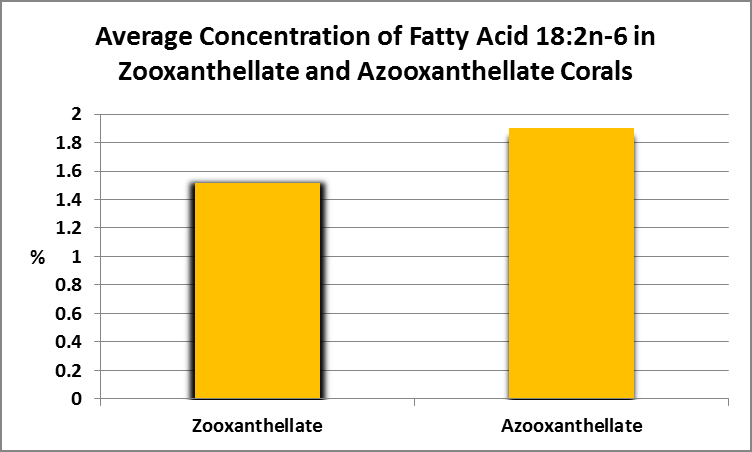
Figure 25. Azooxanthellate corals (such as Tubastrea) contain more of this FA than those corals containing zooxanthellae.
- Number of Carbons: 18
- Shorthand: 18:3 n-6
- Common Name: -linolenic, or GLA
- Comments: In symbiotic corals, this FA is produced mainly by zooxanthellae and likely translocated to the coral animal (demonstrated by Imbs et al (2010) in Acropora and Sinularia corals.) High content is characteristic of Goniopora corals (4.5 – 9.7% of total lipid, as opposed to 0.3-0.4% in azooxanthellate Tubastrea species. High levels (along with 18:4n-3) in corals might be attributed to high amounts of zooxanthellae. Conditionally essential for humans.
- Number of Carbons: 20
- Shorthand: 20:2 n-6
- Common Name:
- Comments:
- Number of Carbons: 20
- Shorthand: 20:3 n-6
- Common Name: Di-homo- -linolenic, or DGLA
- Comments: In symbiotic corals, this FA is produced mainly by the coral animal (demonstrated by Imbs et al (2010) in Acropora and Sinularia corals.) Unusually high in Pocilloporidae corals (Seriatopora caliendrum, Stylophora pistillata, Pocillopora damicornis, and Pocillopora verrucosa (Latyshev et al., 1991) and found mainly in storage (neutral) lipids.
- Number of Carbons: 20
- Shorthand: 20:4 n-6
- Common Name: Arachidonic (either AA or ARA)
- Comments: Major unsaturated FA of some coral tissues. This FA is produced mainly by the coral animal (demonstrated by Imbs et al (2010) in Acropora and Sinularia corals.) One of the predominant PUFAs in Acropora specimens (Latyshev, 1991) and is the main FA of Dendronephthya species (Imbs et al., 2007.) Inhibition of photosynthesis in some microalgae can cause increased biosynthesis of this FA (while synthesis of 20:5n-3 decreases.)
- Number of Carbons: 22
- Shorthand: 22:3 n-6
- Common Name:
- Comments: Found in zooxanthellae and azooxanthellate corals in small amounts of less than 2%.
- Number of Carbons: 22
- Shorthand: 22:4 n-6
- Common Name: Adrenic
- Comments: Can accumulate in tissues due to low desaturase enzyme activity. In symbiotic corals, this FA is produced mainly by zooxanthellae (demonstrated by Imbs et al (2010) in Acropora and Sinularia corals.) Can be made by animals.
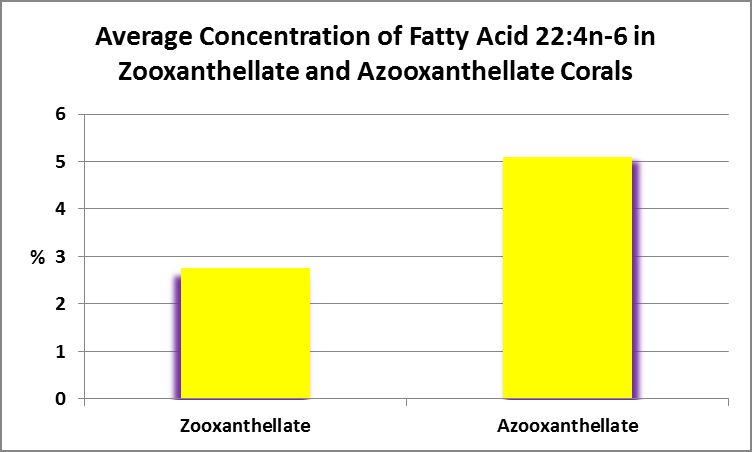
Figure 37. Corals containing zooxanthellae contain less of this FA than those corals not containing zooxanthellae.
- Number of Carbons: 22
- Shorthand: 22:5 n-6
- Common Name: Osbond acid, or DPA.
- Comments: Useful in the chemotaxonomy of azooxanthellate Dendronephthya species. Dinoflagellates cannot make this FA (Gordon and Leggat, 2010) but Imb et al. (2014) found it among lipids in zooxanthellae tissues. At least some animals can make DPA.
- Number of Carbons: 24
- Shorthand: 24:4 n-6
- Common Name: Tetracosatetraenoic
- Comments: Animals can synthesize but not zooxanthellae.
- Number of Carbons: 24
- Shorthand: 24:5 n-6
- Common Name: Tetracosahexaenoic
- Comments: Some animals can synthesize this FA, and it has been shown that soft corals can (but not stony corals) thus making this a chemotaxonomic marker for soft corals (including azooxanthellate Dendronephthya species.) Dinoflagellates cannot make this FA.
- Number of Carbons: 24
- Shorthand: 24:6 n-6
- Common Name:
- Comments: Useful in the chemotaxonomy of azooxanthellate Dendronephthya species.
- Number of Carbons: 28
- Shorthand: 28:7 n-6
- Common Name: OHA
- Comments: Made by dinoflagellates.
Miscellaneous Fatty Acids of Importance
- Number of Carbons: 16
- Shorthand: 16:1 n-7
- Common Name: Palmitoleic Acid
- Comments: Made by animals and zooxanthellae. Conditionally essential for humans.
- Number of Carbons: 16
- Shorthand: 16:1 n-10
- Common Name:
- Comments: Useful for chemotaxonomy of Dendronephthya species.
- Number of Carbons: 16
- Shorthand: 16:2 n-7
- Common Name:
- Comments: Produced by zooxanthellae and likely translocated to the coral host (Imb et al., 2010.)
- Number of Carbons: 16
- Shorthand: 16:3 n-4
- Common Name:
- Comments: Produced by zooxanthellae.
- Number of Carbons: 16
- Shorthand: 16:4 n-1
- Common Name:
- Comments: Produced by zooxanthellae.
- Number of Carbons: 18
- Shorthand: 18:1 n-7
- Common Name:
- Comments: Useful in chemotaxonomy of azooxanthellate Dendronephthya species.
- Number of Carbons: 18
- Shorthand: 18:1 n-9
- Common Name: Oleic Acid
- Comments: Produced by zooxanthellae, algae, and phytoplankton. Third most common FA in Okinawan corals (zooxanthellate soft coral Lobophytum crassum and azooxanthellate Tubastrea), hydrocoral Millepora murrayi) and anemone Boloceroides (Yamashiro et al., 1999) but the highest in Tubastrea colonies from Seychelles (Latyshev et al., 1991.) Content (as a neutral lipid) increased with depth in Stylophora pistillata (3m to 35 m; Latyshev et al., 1991.)
- Number of Carbons: 18
- Shorthand: 18:2 n-7
- Common Name:
- Comments: Possibly produced by the coral animal via the enzyme C16 enlongase. Found in zooxanthellae lipid pools by Imb et al (2014.)
20:U: A description used by Patton et al.1983. Possibly eciosapentaenoic, or EPA- 20:5,found mostly in marine sources such as fish, krill, etc.) Could be 20:4, n-6 or Arachidonic (20:2 n-6.)
22:U: A description used by Patton et al.1983. Possibly docosahexaenoic acid, or DHA – 22:6, found mostly in marine sources such as fish, krill, etc.)
Biosynthesis Pathways of Fatty Acids
Primary producers (plants, algae, zooxanthellae, etc.) can make many FAs, while animals can make others (with many being produced by both primary producers and animals.) Specialized enzymes can lengthen or shorten the FA chain. See Figure 41 for a generalized diagram of biosynthesis pathways.
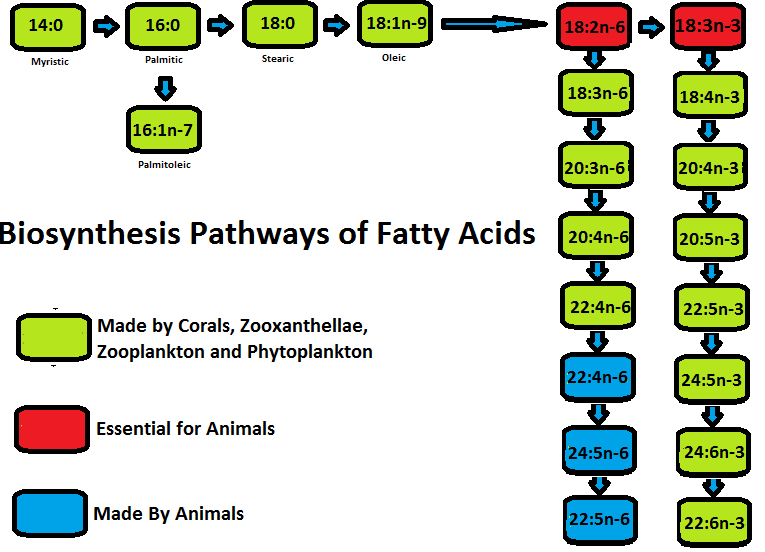
Figure 41. Biosynthetic pathways of Omega-3 and Omega-6 fatty acids (greatly abbreviated.) Plants can produce omega-3 and -6 fatty acids (among others), while animals produce only omega-6 FAs (among others.) Specialized enzymes can alter the composition of FAs.
Observations made by various researchers show lipids are transferred to the coral host from the symbiotic zooxanthellae (Yonge and Nichols, 1931; Crossland et al., 1980; Patton and Burris, 1983.) See Figure 42.
Lipids are the major compounds transferred from zooxanthellae to the coral animal – but which? The answers will require some detective work. Various researchers have described fatty acids produced by zooxanthellae. If we take this information and plug it into the pathways shown in Figure 41, we arrive at an idea of zooxanthellaes’ abilities to make, and potentially share, Fatty acids. Figures 43 and 44 show Omega-3 and Omega-6 fatty acid synthesis, respectively. (Note: The red marker indicates a FA considered essential for animals. Low content in the pathways might indicate high enzyme activity where fatty acid is rapidly converted to the next FA.)
This concludes our discussion of fatty acids found in corals and zooxanthellae. Next time, we’ll examine the fatty acid content of specific corals (including some considered to be difficult to maintain in captivity such as some Goniopora species and soft corals such as Dendronephthya.)



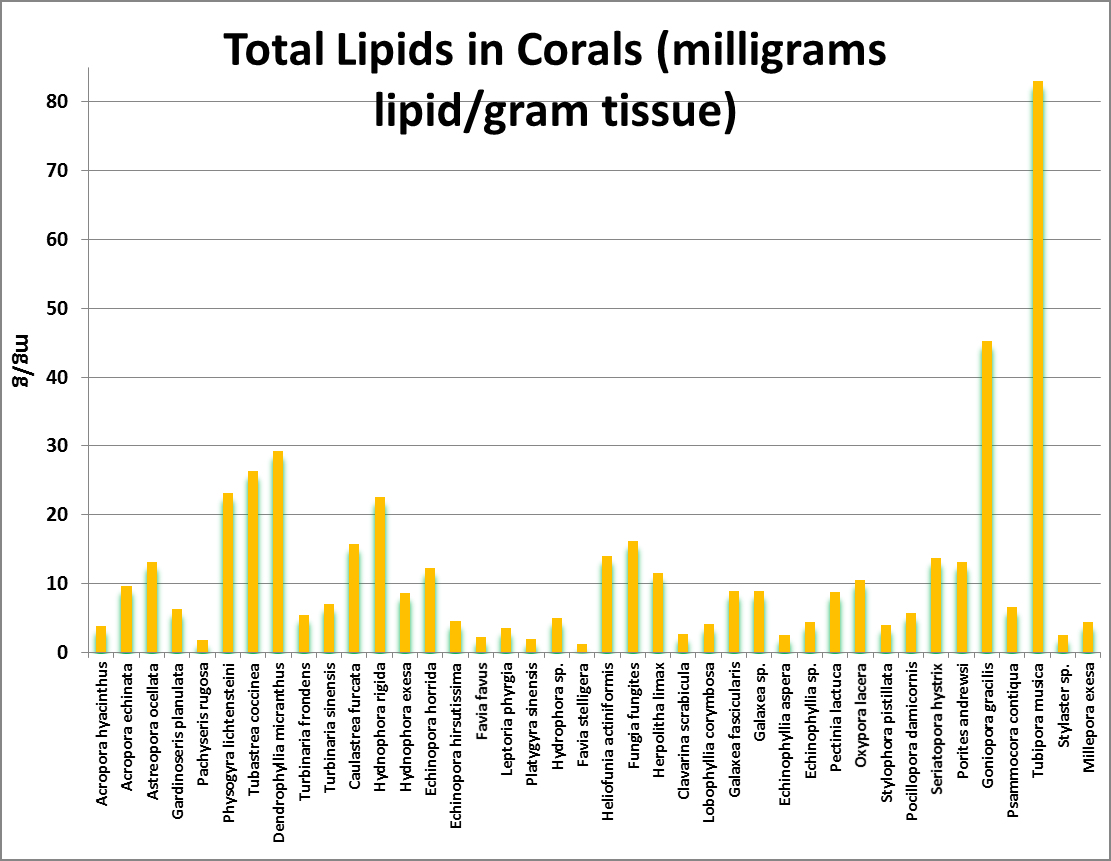
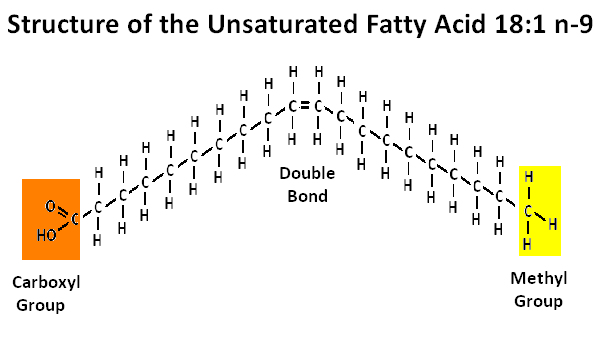
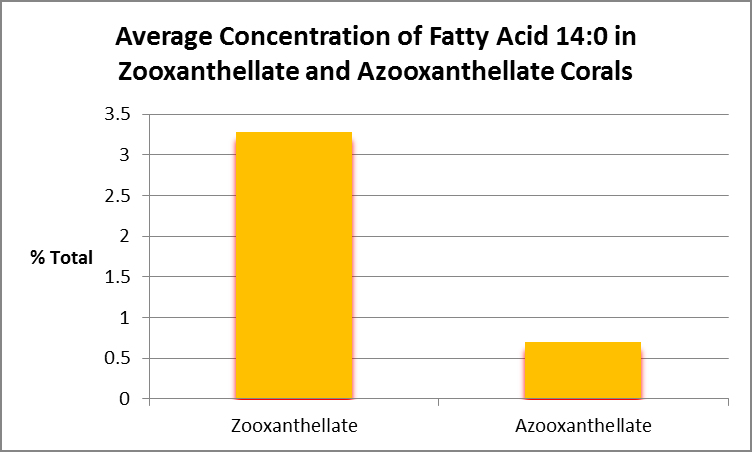
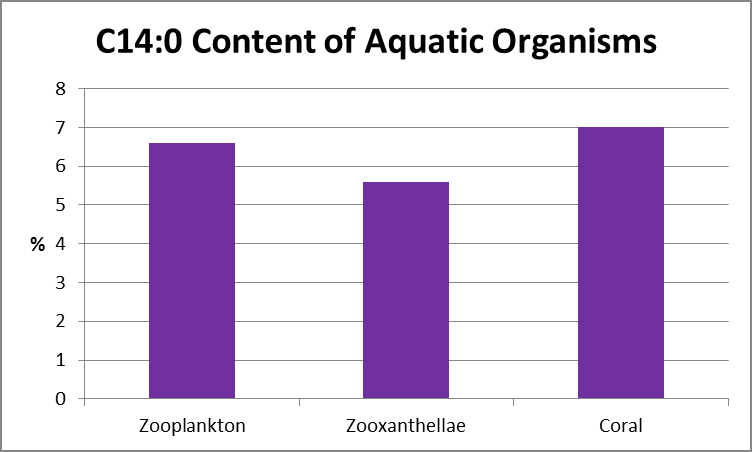
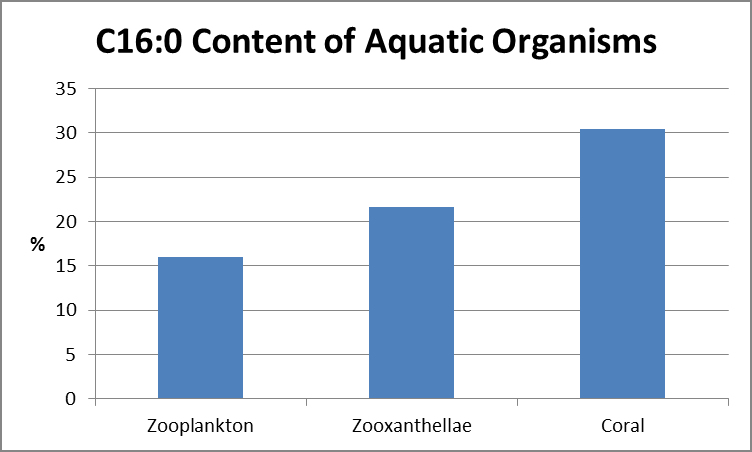

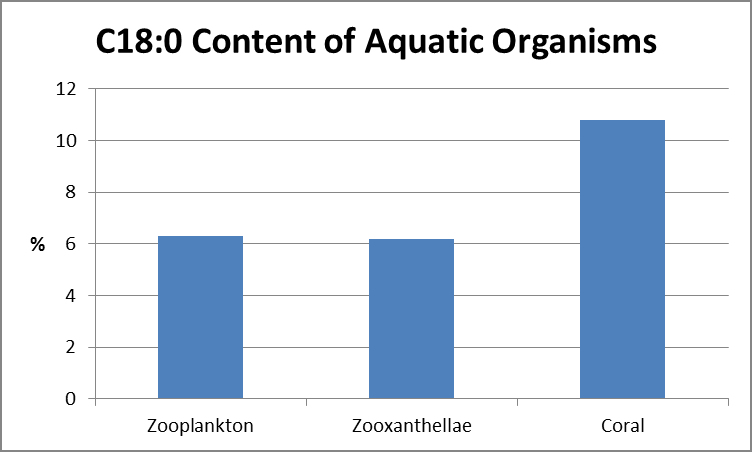
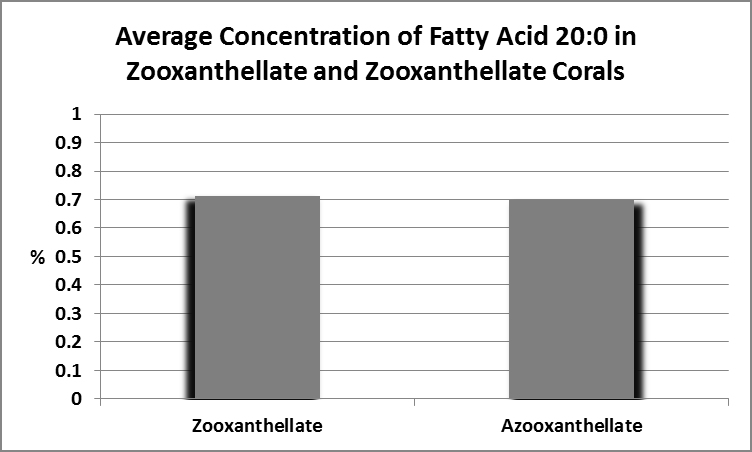
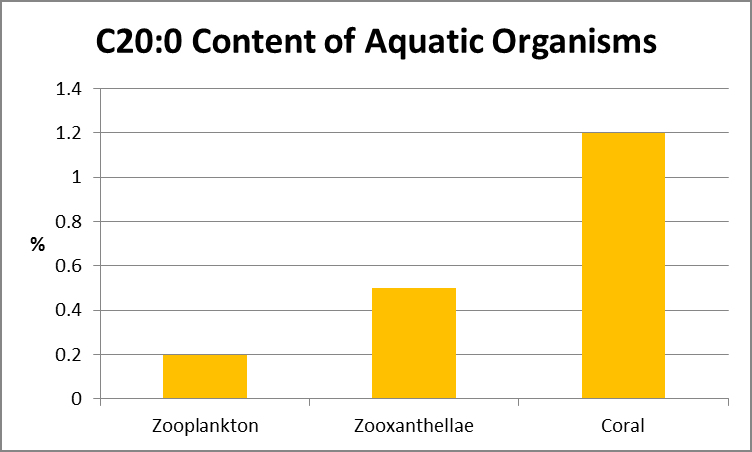
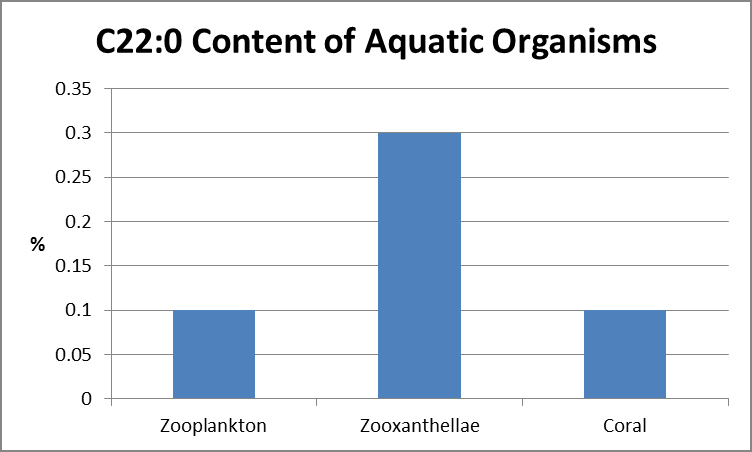
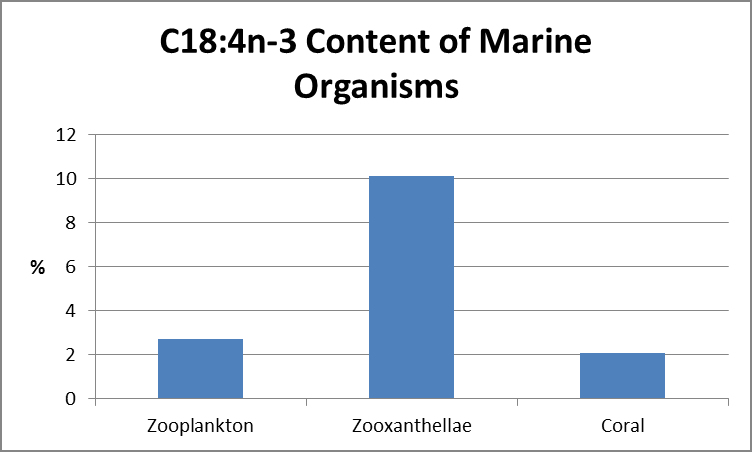
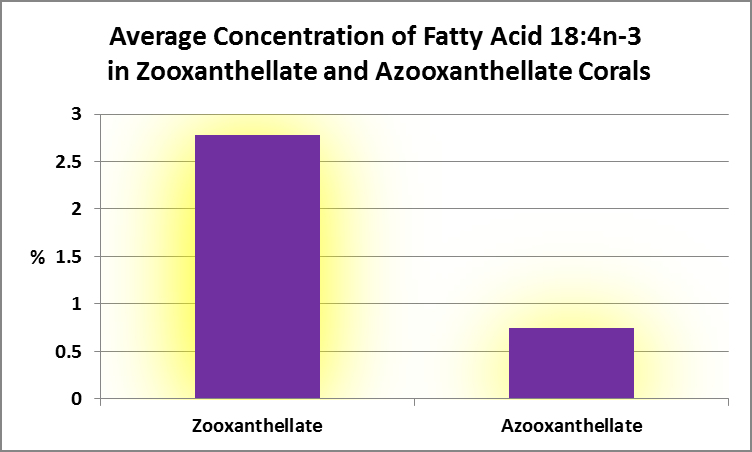
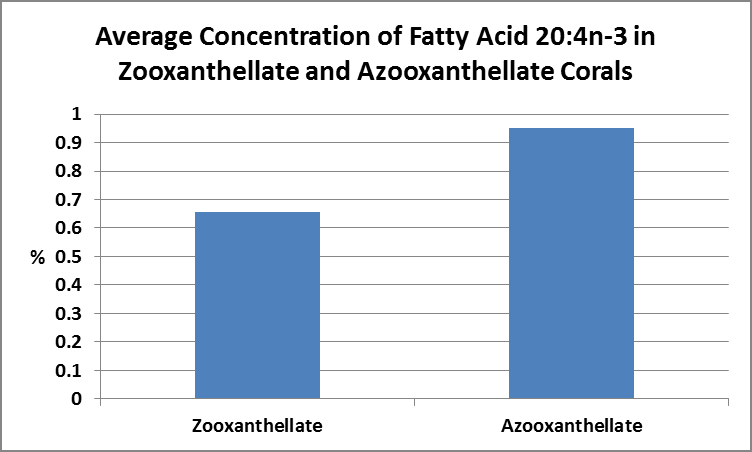

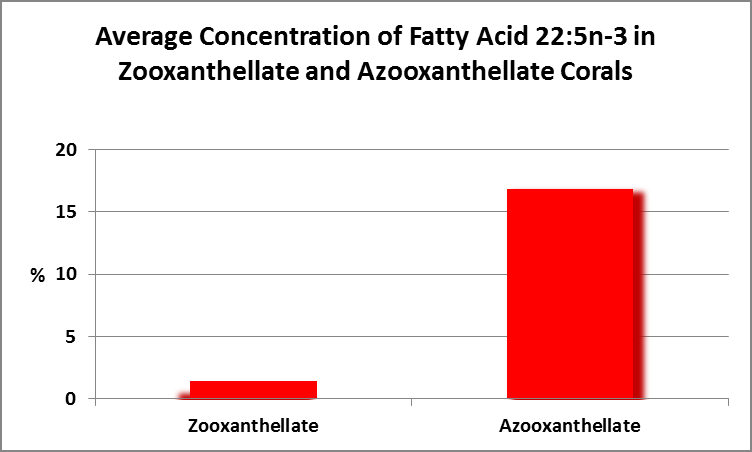
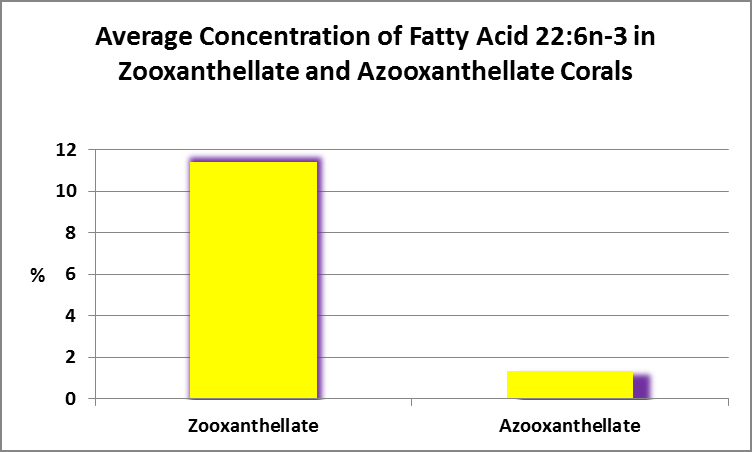
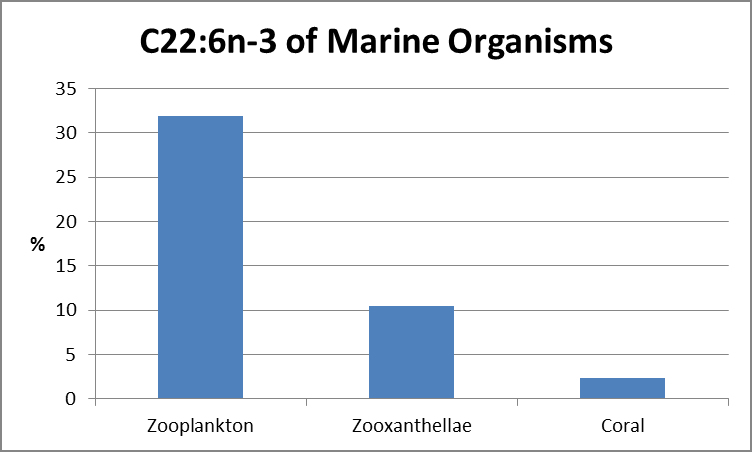
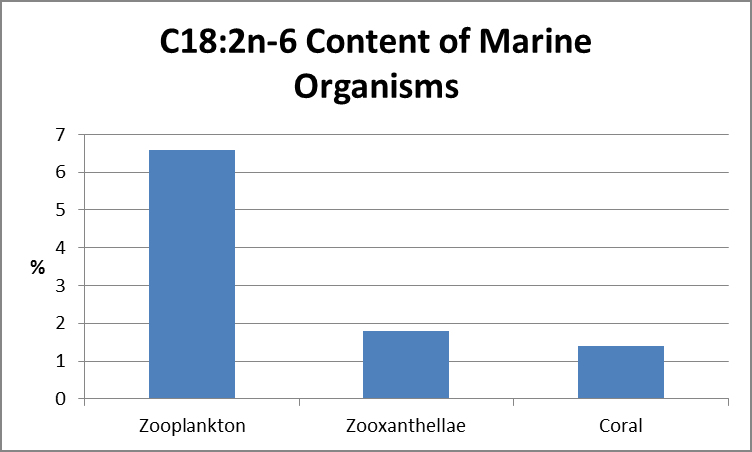
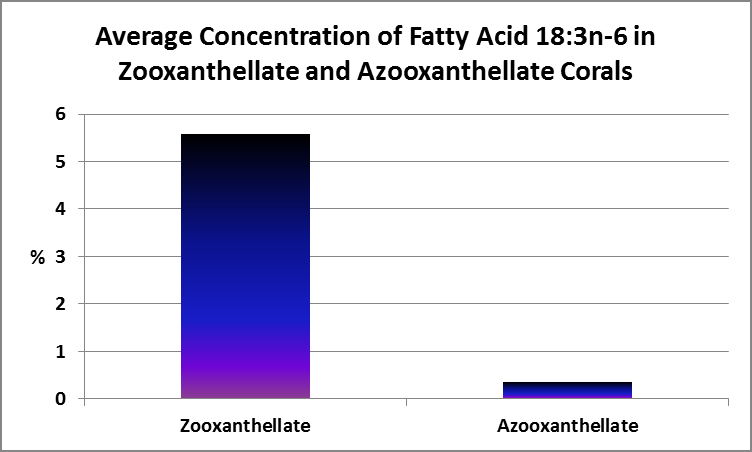
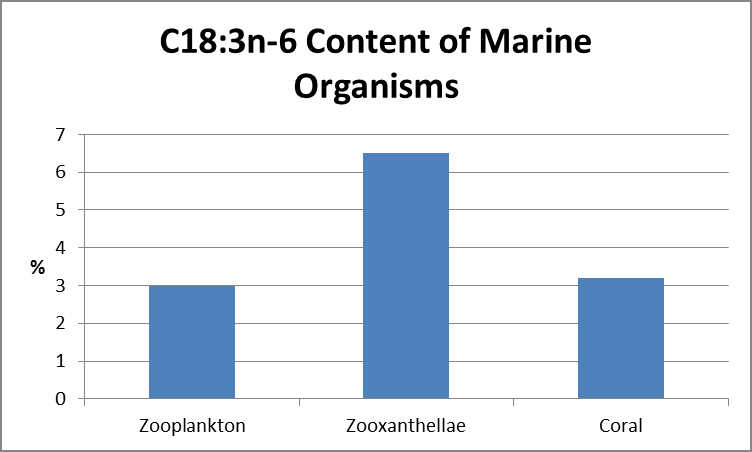


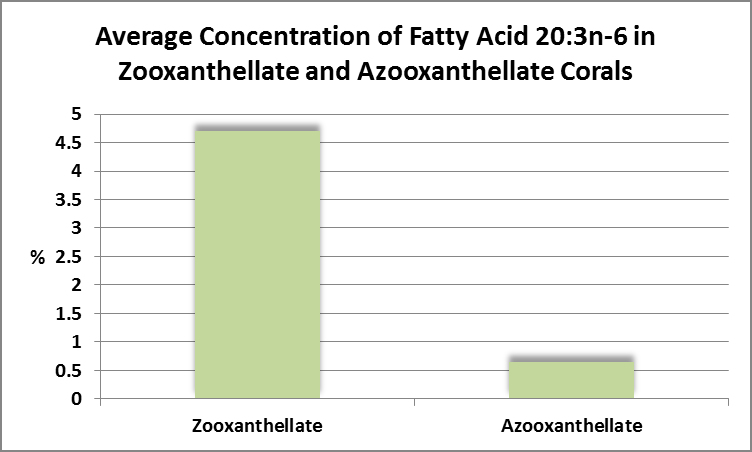
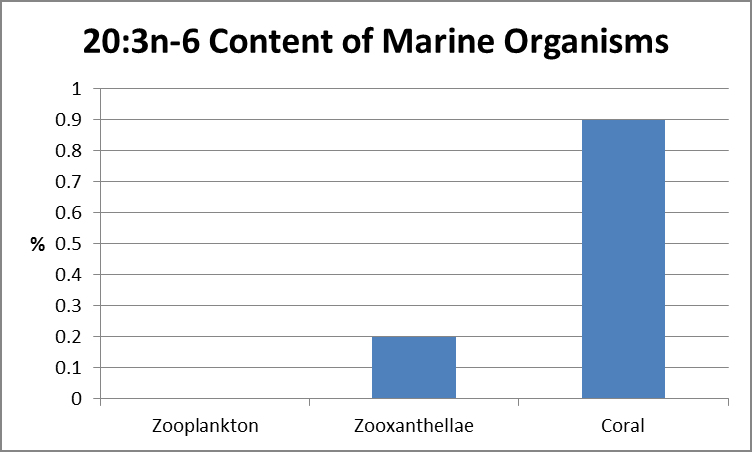
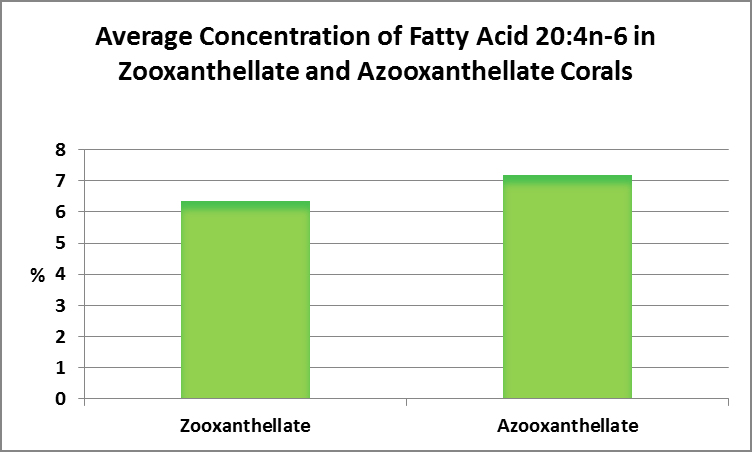
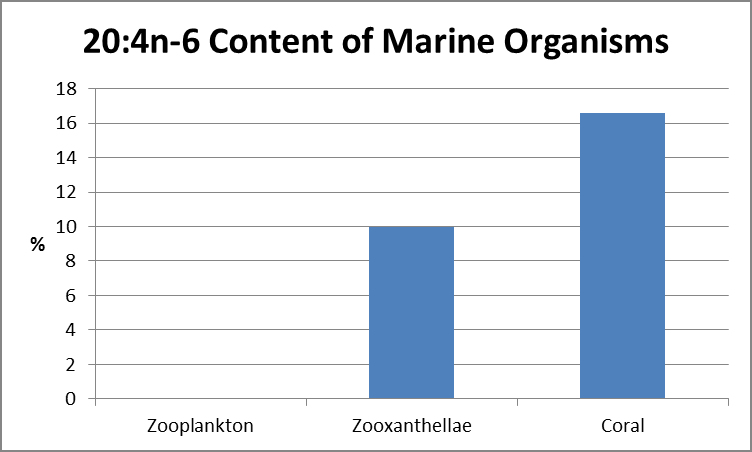
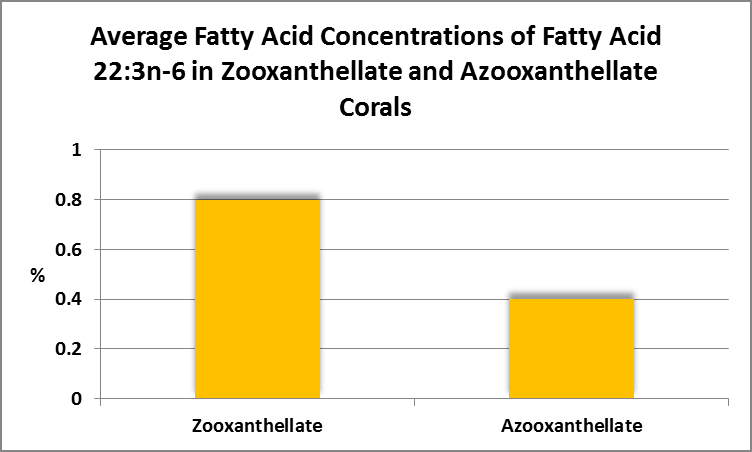
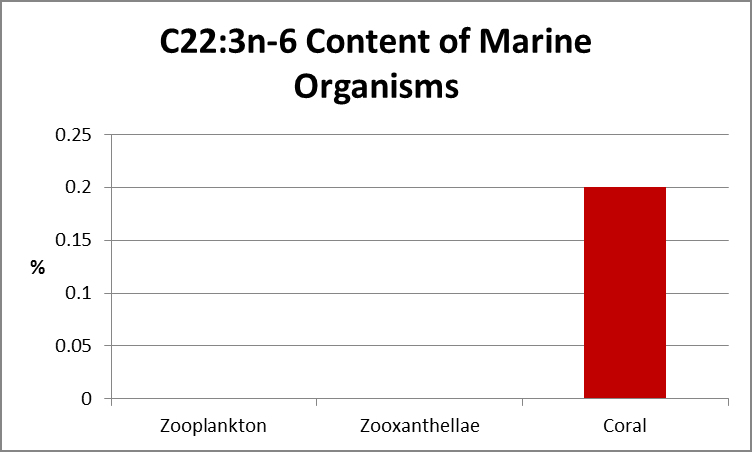
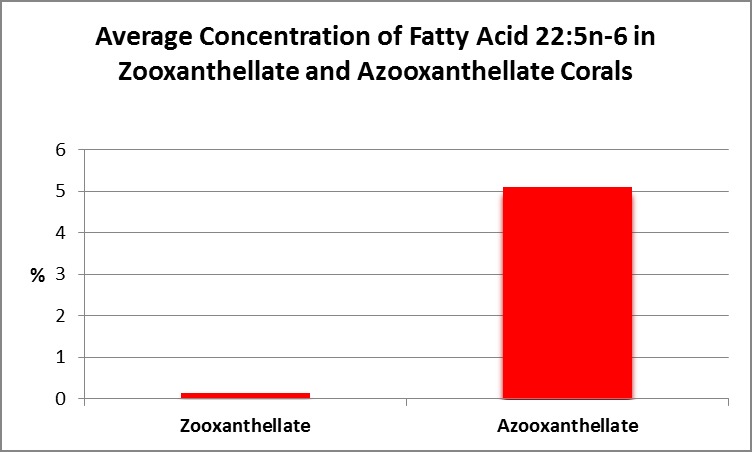
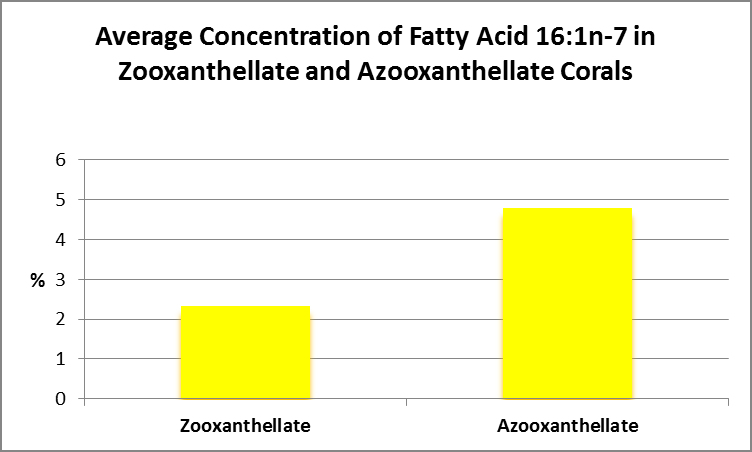

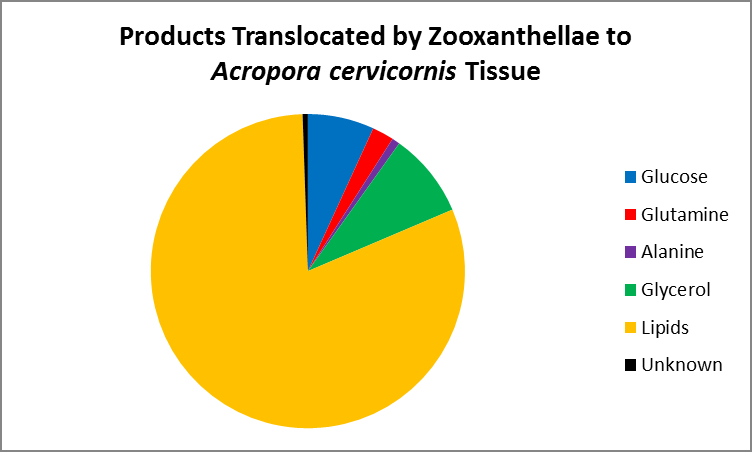
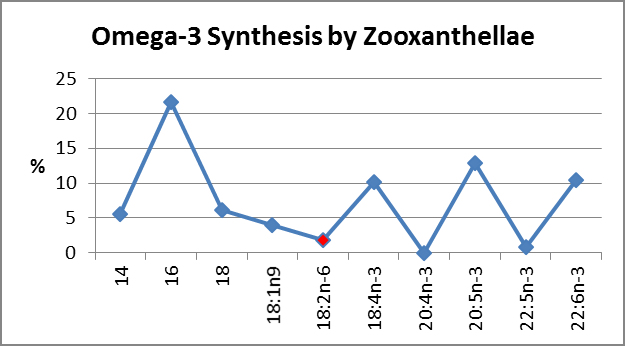
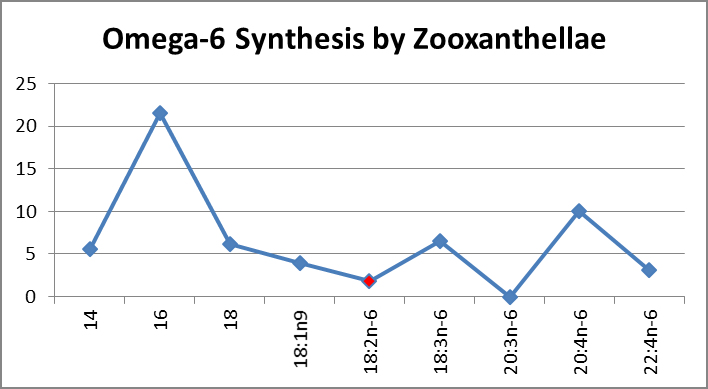

0 Comments